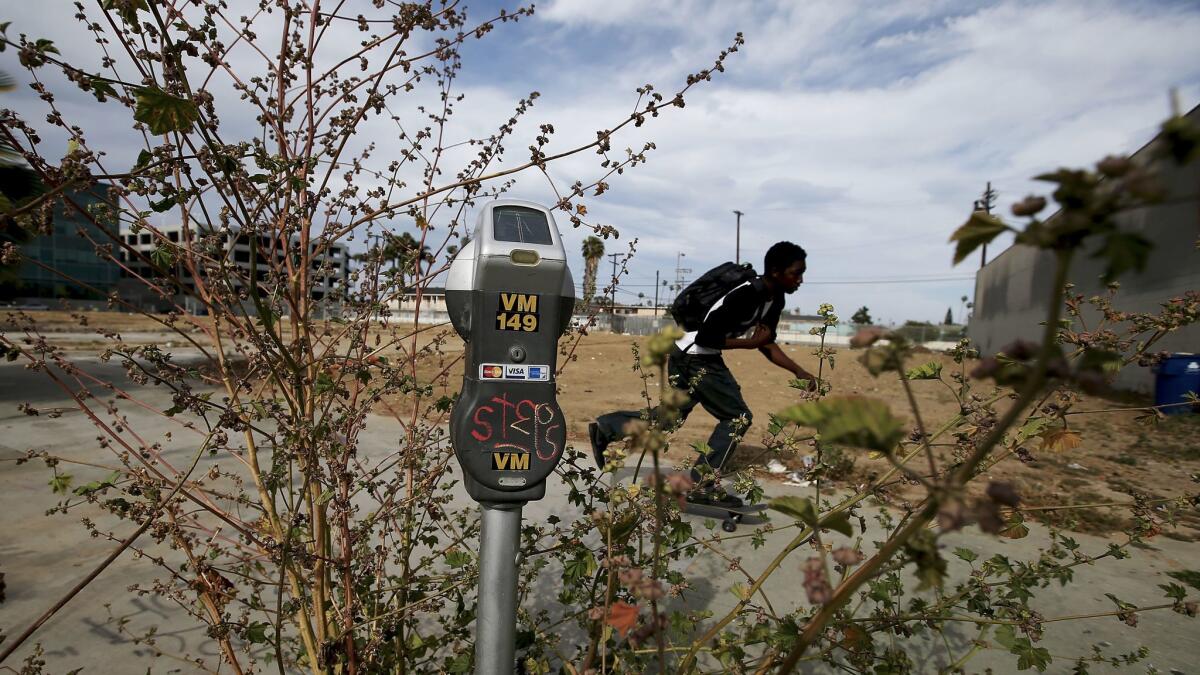‘It looks bad. It’s dangerous.’ Vacant lots dotting South L.A. a painful reminder of L.A. riots

- Share via
For almost a quarter of a century, the bare patch of land near the corner of Western Avenue and West Adams Boulevard has sat empty.
Neighbors faintly remember it was once a medical office. Years before that, a historic bank operated on the same site, a pioneering enterprise founded by a black businessman. And city records show that still earlier, it was home to a hot dog stand.
But when riots engulfed South Los Angeles, spurred by the acquittal of four white police officers in the beating of black motorist Rodney King, the Western Avenue site went up in flames. Burned beyond repair, the building was torn down. And nothing has arisen since.
Across the street? Another empty lot. And it too dates back to the devastation of 1992.
Back then, there were “promises about rebuilding South L.A. in a different way,” said Kerman Maddox, a public affairs consultant who lived near those sites during the unrest. “For those lots to remain vacant 25 years later is pretty disappointing.”
By some measures, South L.A. has seen marked improvements since the riots, including notably lower crime and, at least in some areas, more economic development. Churches, schools, markets and restaurants sit at many sites that were once scorched or vandalized, a testament to efforts to rebuild.
But there is also a scattering of empty lots that dates back to the riots, a stubborn reminder that the repeated vows to “rebuild L.A.” were never fully realized.
City Councilman Marqueece Harris-Dawson lamented that as other stretches of the city have been transformed by development, investors have remained skittish and ignorant of many black and Latino neighborhoods south of the 10 Freeway. Even wealthy parts of South L.A. have had to fight for shops and restaurants that flock to other parts of the city, he said.
By now, the councilman said, the financial sector should have moved past the memories of the violence. “We had wars with countries that were rebuilt 25 years later,” said Harris-Dawson, who represents many of the South Los Angeles neighborhoods hit by the riots. “Germany and Japan were rebuilt 25 years later.”
The most notorious is a vast stretch of empty land at Vermont and Manchester avenues, which has been a perpetual frustration to politicians and community leaders. But smaller patches of vacant land have also persisted along busy corridors such as Western Avenue, even as real estate development has spurred bitter battles in other neighborhoods.
In the Broadway-Manchester neighborhood, an empty lot lingers next to a swap meet, littered with takeout containers and a discarded toilet. Another sits next to an Exposition Park car wash, where a passing woman fretted about homeless people frequenting the vacant lot.
“It looks bad. It’s dangerous,” said Rosaisela Espinoza de Garcia, 65, who has lived in the neighborhood for more than a decade and frequently passes the lot on her way to the market. “It scares us.”
Immediately after the riots, there was a push to rebuild the area, said County Supervisor Mark Ridley-Thomas, who was representing some of the hardest hit neighborhoods as a city councilman at the time. But he said that after the Northridge earthquake rocked the city two years later, public attention — and dollars — shifted to the earthquake victims.
Cal State L.A. economics professor Tom Larson found in a survey that many building owners wanted to rebuild, but were frustrated by problems getting financing. Few were able to get bank loans.
A year and a half after the riots, more than half of the damaged properties had no signs of reconstruction, Larson and a colleague found in a 1996 study. The Times followed up five years after the unrest, discovering that roughly 200 vacant properties remained. Today, Larson is trying to calculate exactly how many are still empty, a task complicated by flawed and sometimes imprecise government records.
When Linda Griego took over Rebuild LA, the nonprofit that then-Mayor Tom Bradley had formed immediately after the riots, her job was to transform the promises made by businesses into brick-and-mortar progress. It wasn’t until 2000 — three years after the organization dissolved — that Griego said she began to see some of the shopping centers they had clamored for.
One of the challenges was finding businesses that would squeeze into the space available. Larson said that then and now, one of the biggest barriers to new development is the small size of many South Los Angeles lots.
“These were often just little mom-and-pop stores. And people don’t shop there anymore,” the economics professor said. “They want to go to big-box retail.”
The roughly 3-acre span of land at Vermont and Manchester is an exception, which makes it all the more maddening to politicians that it still sits empty. As the sun bore down on a recent afternoon, John Walker was walking with his 64-year-old neighbor to the corner store when he quizzed her: What had once been there?
The 22-year-old had seen a homeless camp pop up on the expanse. He had seen clothing hangers arrayed on the wire fence that surrounds it, an informal market for people hawking clothing. He had seen it strewn with litter, a community eyesore. That land had sat empty since before he was born.
Mae Cole rattled off the long history: a department store where she shopped as a kid, burned down in an earlier round of riots. A swap meet that sprung up to replace it. And then another round of violence and flames — and the emptiness that followed.
“It was really nice up in here,” Cole said, shielding herself from the sun with a black umbrella. “It’s a shame they haven’t done anything with this.”
Two years ago, longtime property owner Eli Sasson trumpeted plans to build a massive entertainment district there, one that he said would rival the Staples Center. But nothing has happened since.
Sasson blames a legal battle with an obscure government agency — the successor to the Community Redevelopment Agency — over the price of a parking lot that he wants to fold into the project.
“We are ready to build. Who’s holding the key? It’s the CRA,” he said.
Harris-Dawson rejected the idea that Sasson couldn’t move forward without the parking lot and complained that Sasson had dragged down the entire neighborhood. He argued that the city needed tools to prod owners of blighted property to either develop it — or give it up.
“What’s the price for doing nothing?” the councilman asked.
Experts cite a long list of systemic and historic forces that have quashed development in the area, including surging economic inequality and the elimination of redevelopment agencies. But other barriers are more mundane. Several people pointed out that the Department of Building and Safety does not keep a readily accessible list of empty lots, which makes it harder to steer developers toward possible properties.
“It’s a matter of what is a priority,” said Paul Ong, director of the Center for Neighborhood Knowledge at UCLA. “It’s a matter of will. And it’s a matter of putting in the resources to do it.”
Despite the obstacles, South L.A. has a growing crop of success stories: The Chesterfield Square shopping center, which includes a grocery store and a Starbucks, arose in a neighborhood that was once battered by the unrest. Housing for the homeless is being discussed at the corner of 88th Street and Vermont, where stores once burned to the ground.
Beyond the specific sites that were damaged in the riots, Griego also pointed to the opening of the Juanita Tate Marketplace on Slauson and Central avenues, which boasts a Northgate market, a drugstore and a Yogurtland. That center took almost two decades to build, she said.
“Here was neglect for like four decades, and a five-year nonprofit was not supposed to solve that,” Griego said. “It takes decades to fix it back. And that’s what it has taken. We were the seed.”
Today, land scarcity and the housing crisis could prod developers to give South Los Angeles a second look, said Brenda Shockley, the former president of the nonprofit community development corporation Community Build, which was created to revitalize areas that were destroyed in the riots. New rail lines and the nearby football stadium in Inglewood could accelerate those forces, Shockley said.
Along Western Avenue, a Southern California company is now floating the idea of building a Best Western hotel at the empty lot near Adams Boulevard, the one that had been empty since the riots. Christopher Slattery, the CEO of Hospitality Resource Group, said a new owner is interested in erecting a three-story hotel with a pool at the site.
The nearby neighborhoods of West Adams and Jefferson Park boast historic districts with Craftsman bungalows that cost $700,000 or more. The area has become one of the hottest real estate markets across the city, spurring buzz and fear about gentrification by the white and wealthy. Yet Slattery said some “name brand” hotel chains looked askance at the Western Avenue location.
“It takes someone to put the stake in the ground,” he said.
The hotel idea is welcome news to nearby resident Hunter Ochs, who says he phones the city every few weeks to report illegal dumping and other nuisances at the empty lot down the street. At one point, someone got into the basement of the demolished building, Ochs remembers. Bringing a major brand into the neighborhood is important, he said.
“It sends a meaningful signal to people that drive by that this neighborhood is not going down, but coming up in value and viability and marketability,” Ochs said.
But some neighbors have eyed the idea of a hotel with suspicion, fearing it could become a magnet for prostitution.
“They’re afraid to have this thing built,” said Leslie Evans, president of the Van Buren Place Block Club. “But I don’t see anyone else who’s going to have something built there.”
Twitter: @LATimesEmily
Twitter: @angeljennings
He tried to cool a city’s anger, only to watch helplessly as it burned during the 1992 riots
Reader stories about the L.A. riots
More to Read
Sign up for Essential California
The most important California stories and recommendations in your inbox every morning.
You may occasionally receive promotional content from the Los Angeles Times.












